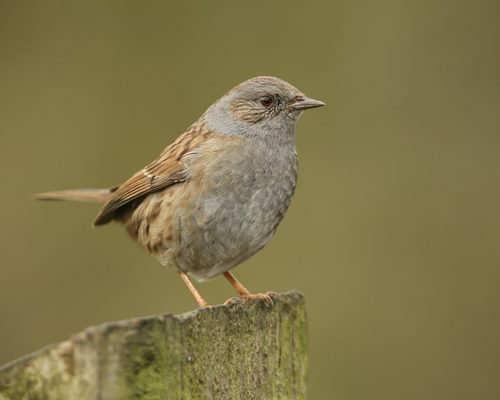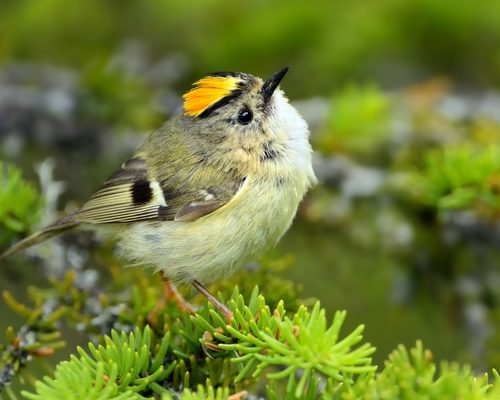Eurasian Wren
Troglodytes troglodytes
Visual Identification
Appearance
The Eurasian Wren is a tiny, plump bird with a short tail often held upright. Its upperparts are rich brown with fine, dark barring, while the underparts are paler with variable barring. The bird has a prominent pale eyebrow stripe and a thin, slightly curved bill.
Males and females look alike, with juveniles resembling adults but showing less distinct barring. The wren's plumage remains consistent year-round, with no seasonal variations.
Juveniles appear similar to adults but have streaking on the breast and less barring on the flanks. Their overall colour is a warmer reddish shade, and they may still have a bright yellow gape to encourage feeding from their parents.
Size
Length
9cm to 10cm
Wingspan
13cm to 17cm
Weight
7g to 12g
Colours
Males and females have similar plumage
Primary Colour
Brown
Secondary Colour
Buff White
Beak Colour
Brown
Leg Colour
Pink
Habitat and Distribution
Habitats
Woodland
Garden
Wetland
Coastal
Urban
Farmland
Grassland
Desert
Tundra
Rainforest
Mountain
Savanna
Distribution
The Eurasian Wren is widely distributed across Europe, Asia, and North Africa. It inhabits a variety of environments, including woodlands, hedgerows, gardens, and rocky areas with dense vegetation.
This wren is a common resident of the UK and is found throughout the country. Some northern populations may move south during harsh winters, while those in milder regions tend to be sedentary.
Elevation Range
Sea level to 4,575 meters
Climate zones
Temperate, Subarctic
Distribution Map
This map gives you a rough idea of where you might spot a Eurasian Wren. The coloured areas show countries where these birds have been seen.
A few things to keep in mind:
- Birds might not be everywhere in the coloured areas, for example, they may be present around the coast of that country
- Where birds live can change with seasons and available food
- This map is quite simple - it doesn't show exact locations
We're working on making our maps even better! Soon, we hope to show you:
- More detailed maps for bigger countries, including state and region
- How birds move around during different seasons
Distribution by Region
Behaviour and Ecology
Bird Attributes
This feature is in beta. We'd love your feedback to improve it!
Share your thoughtsBird Attributes Explained
Our bird attributes system rates various aspects of a bird's capabilities on a scale of 0-100, based on data from field observations, scientific studies, and expert knowledge.
Attribute Categories:
- Agility: Manoeuvrability, speed, and grace in flight or movement.
- Strength: Physical power, often correlating with size and hunting abilities.
- Adaptability: Ability to thrive in various environments or changing conditions.
- Aggressiveness: Territorial behaviour and assertiveness, particularly during breeding seasons.
- Endurance: Stamina, often seen in migration patterns or foraging behaviours.
Understanding the Ratings:
- 0-20: Very Low
- 21-40: Low
- 41-60: Average
- 61-80: High
- 81-100: Very High
Remember, these attributes are relative to other bird species and don't necessarily indicate superiority.
Hover over the icon next to each attribute for more information.
Tap the icon next to each attribute for more information.
Agility
Reflects the bird's manoeuvrability, speed, and grace in flight or movement.
The Eurasian Wren displays remarkable agility, constantly flitting through undergrowth and climbing vertically on tree trunks and walls. Its ability to navigate dense vegetation and explore crevices demonstrates exceptional manoeuvrability for its size.
Strength
Indicates the bird's physical power, often correlating with size and hunting abilities.
As one of Europe's smallest birds, the Eurasian Wren has limited physical strength. However, it can still manage tasks like nest-building and foraging effectively, despite its diminutive size.
Adaptability
Represents the bird's ability to thrive in various environments or changing conditions.
This species shows high adaptability, inhabiting a wide range of environments from sea level to 4,575 metres. Its ability to thrive in various habitats, including woodlands, gardens, and urban areas, indicates strong adaptive capabilities.
Aggressiveness
Measures the bird's territorial behaviour and assertiveness, particularly during breeding seasons.
Despite their small size, Eurasian Wrens are fiercely territorial. Males vigorously defend their areas through loud, complex songs and engage in intense 'song battles'. This behaviour suggests a relatively high level of aggressiveness for their size.
Endurance
Reflects the bird's stamina, often seen in migration patterns or foraging behaviours.
The Eurasian Wren demonstrates good endurance through its constant activity and ability to survive in diverse climates. However, severe winters can cause significant population declines, indicating some limitations to its endurance in extreme conditions.
Diet
Eurasian Wrens primarily feed on small invertebrates, including spiders, insects, and their larvae. They forage in low vegetation, leaf litter, and crevices, using their thin bills to probe for prey. In winter, they may occasionally supplement their diet with small seeds and berries.
Behaviour
Eurasian Wrens are remarkably active, constantly flitting through undergrowth and exploring crevices for food. They often hop and climb vertically on tree trunks and walls, probing for insects.
Despite their small size, these wrens are fiercely territorial. Males vigorously defend their areas through loud, complex songs.
Vocalisation
The Eurasian Wren's song is remarkably loud for its size, consisting of a rapid series of high-pitched trills and warbles. It often ends with a distinctive rattling trill. The call is a sharp, metallic 'tic-tic-tic'. During territorial disputes, males engage in intense 'song battles'.
Nesting & Breeding
Breeding season for Eurasian Wrens typically begins in April. Males build several dome-shaped nests from moss, leaves, and grass, often in cavities or dense vegetation. Females select one nest and line it with feathers.
The female lays 5-8 white eggs with reddish-brown spots. She incubates the eggs alone for about 16 days, while the male may continue to maintain other nests.
Both parents feed the nestlings, which fledge after 17-19 days. Pairs often raise two broods per season and, in some cases, may attempt a third.
Conservation and Status
Global Conservation Status
While the Eurasian Wren is currently listed as Least Concern, it faces threats from habitat loss and climate change. Severe winters can cause significant population declines.
Conservation efforts focus on maintaining suitable habitats, including dense undergrowth in woodlands and gardens.
Birdwatching Tips
- Look for movement in low vegetation and near the ground
- Listen for their loud, trilling song, especially in spring
- Check crevices in walls, tree roots, and dense bushes
- Observe early morning when they are most active
- In the UK, watch for them in gardens and woodlands year-round
Additional Information
Quick Facts
Other names:
Winter Wren, Northern Wren, Jenny Wren
Family:
TroglodytidaeAverage Lifespan
2 to 3 years
Predators
Main predators include domestic cats, small raptors like sparrowhawks, and occasionally larger songbirds such as jays.
Did You Know?
- The Eurasian Wren is one of the smallest birds in Europe, yet it has one of the loudest songs relative to its size.
- In cold weather, these wrens may huddle in large groups to stay warm, sometimes with over 60 birds in a single nest box.
- The species name 'troglodytes' means 'cave-dweller', referring to its habit of nesting in cavities and crevices.
- Wrens have the nickname Jenny Wren. This is because females get extremely vocal when her newly fledged brood is on site.
FAQs
Are Wrens good to have around?
Wrens, like most other birds, are wonderful to have in the garden. These busy little birds have a lovely voice and actively forage for pest insects like aphids around our homes.
Why do Wrens constantly chirp?
Wrens may call excitedly when faced with a threat like a cat or a dog. They will also chirp boldly at Magpies, which often raid other birds' nests.
How to attract Wrens
Wrens are not the most common visitors to bird tables, although you can attract them with the right foods. Your best chance is an open, platform-style feeder stocked with mealworms, suet, and peanuts.
A bird bath or pond will act as an added attraction, and the addition of a purpose-made Wren nest box might attract a breeding pair of these delightful birds.
What is a group of Wrens called?
Known collective nouns for a group of Wrens are as follows:
- a chime of wrens
- a flight of wrens
- a flock of wrens
- a herd of wrens
Similar Birds
References
- 1 2
website: BirdLife International. 2018. Troglodytes troglodytes. The IUCN Red List of Threatened Species 2018: e.T103883277A132200296.
View source - 3
report, 2015: EBCC
Share Your Feedback
We value your opinion! Let us know what you think about this bird page.

